1880s-1890s: The Victorian Era
In 1882, Charles Milton Bell introduced a tighter arrangement and an elaborate setting, surrounding the Justices with ornate backgrounds and Oriental rugs.
The Waite Court, Late 1882
C. M. [Charles Milton] Bell (1848-1893)
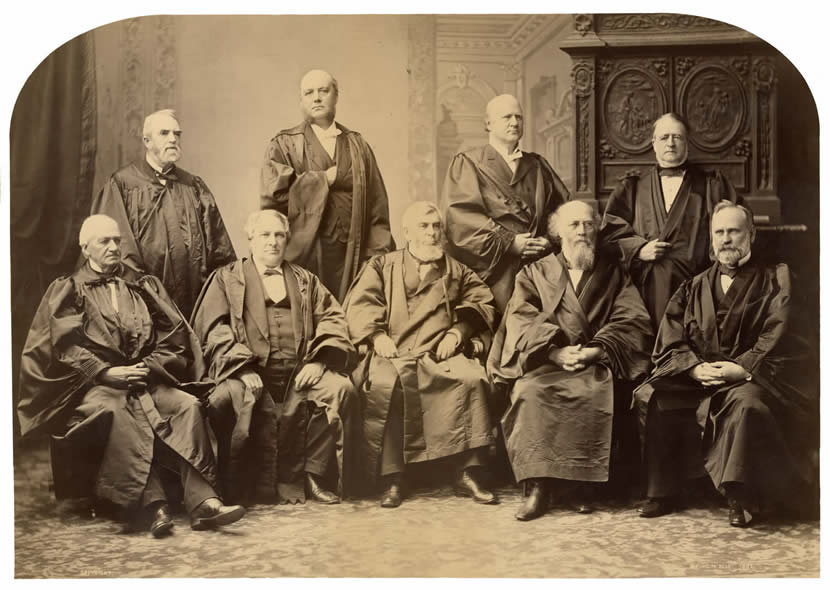 Seated, from left: Justices Joseph P. Bradley and Samuel F. Miller, Chief Justice Morrison R. Waite, and Justices Stephen J. Field and Stanley Matthews; standing, from left: Justices William B. Woods, Horace Gray, John Marshall Harlan, and Samuel Blatchford
Seated, from left: Justices Joseph P. Bradley and Samuel F. Miller, Chief Justice Morrison R. Waite, and Justices Stephen J. Field and Stanley Matthews; standing, from left: Justices William B. Woods, Horace Gray, John Marshall Harlan, and Samuel Blatchford
With the Court’s fourth group photograph, portrait photographer C. M. Bell made some dramatic changes. While the first three photographers posed the Court in a row to echo how visitors saw them during oral arguments, the pragmatic Bell broke the single row in two. This allowed him to move his camera closer to the Justices, which brings them closer to the viewer. Instead of posing his subjects in front of a blank wall, he posed them on an ornate carpet and surrounded them with new and fashionable Victorian scenery.
With print sales clearly in mind, Bell mounted prints on special presentation boards with the names of the Justices printed below, as Gardner and the Fassetts had also done. This portrait of the Justices proved so popular that at least three different mounts exist, and after each sold out it was reissued. The earliest known example of a group photograph signed by all of the Justices is of this pose.
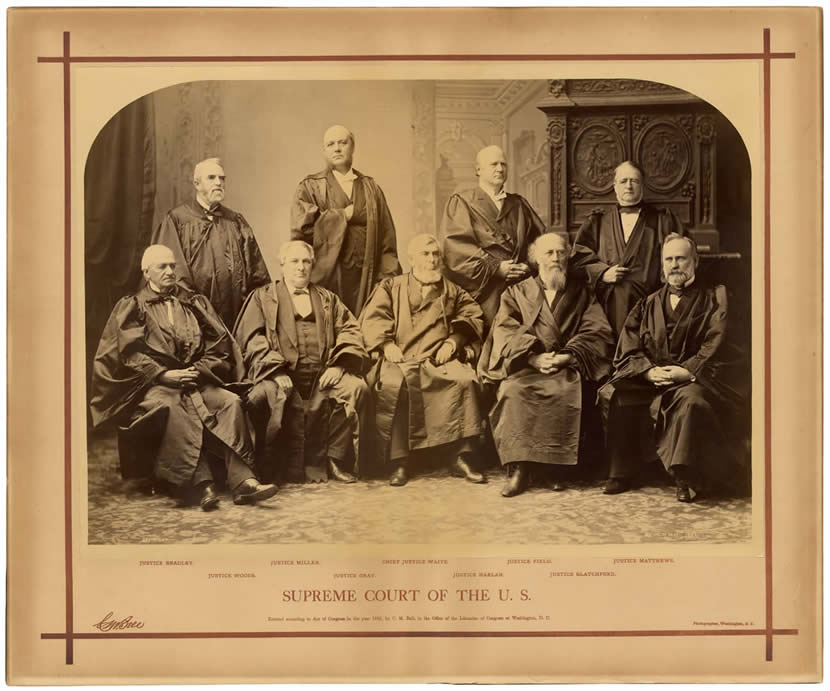
The Waite Court, February 1886
George Loren Prince (1848-1929)
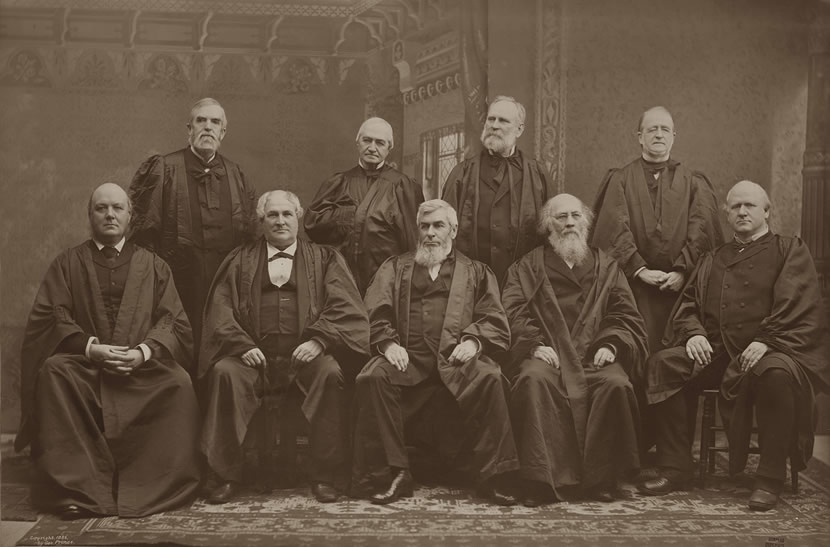 Seated, from left: Justices Horace Gray and Samuel F. Miller, Chief Justice Morrison R. Waite, and Justices Stephen J. Field and John Marshall Harlan; standing, from left: Justices William B. Woods, Joseph P. Bradley, Stanley Matthews, and Samuel Blatchford
Seated, from left: Justices Horace Gray and Samuel F. Miller, Chief Justice Morrison R. Waite, and Justices Stephen J. Field and John Marshall Harlan; standing, from left: Justices William B. Woods, Joseph P. Bradley, Stanley Matthews, and Samuel Blatchford
During the 20 years that followed Gardner’s first group photograph the Justices posed infrequently, gathering on five different occasions for five different photographers. Their visit to the studio of George Prince, the last of the five sittings, is unusual because it is the first occasion the same group of Justices posed a second time. When the Justices visited Prince’s studio in February 1886, he was truly the new young “prince” of Washington portrait photographers. He was celebrated for his artistic compositions and beautifully finished prints, and local newspapers regularly gushed over his sittings with famous clientele.
A close comparison of these two poses reveals that great time and care went into this session: Prince repositioned the Justices and rearranged backdrops, changed his camera position, and used a riser (actually, a lemon crate) for Justice Bradley, who is in the back row but clearly taller in the final version. Several Justices made adjustments to their robes and bow ties; it was no doubt a long session. The Justices’ appreciation of his artistry may have been outweighed by a collective impatience, for the next time they sat together two years later it was at Bell’s studio, which became their primary studio for the next 23 years.
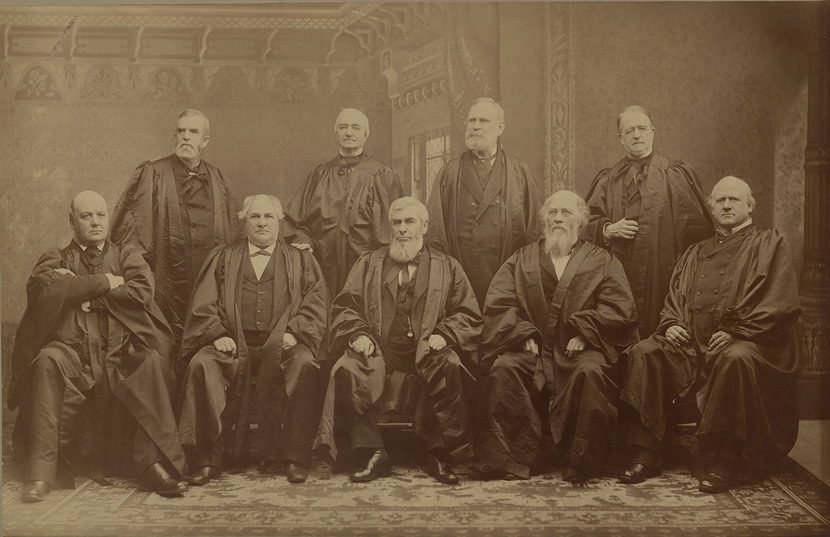
The Fuller Court, February 1890 [signed]
Napoleon Sarony (1821-1896)
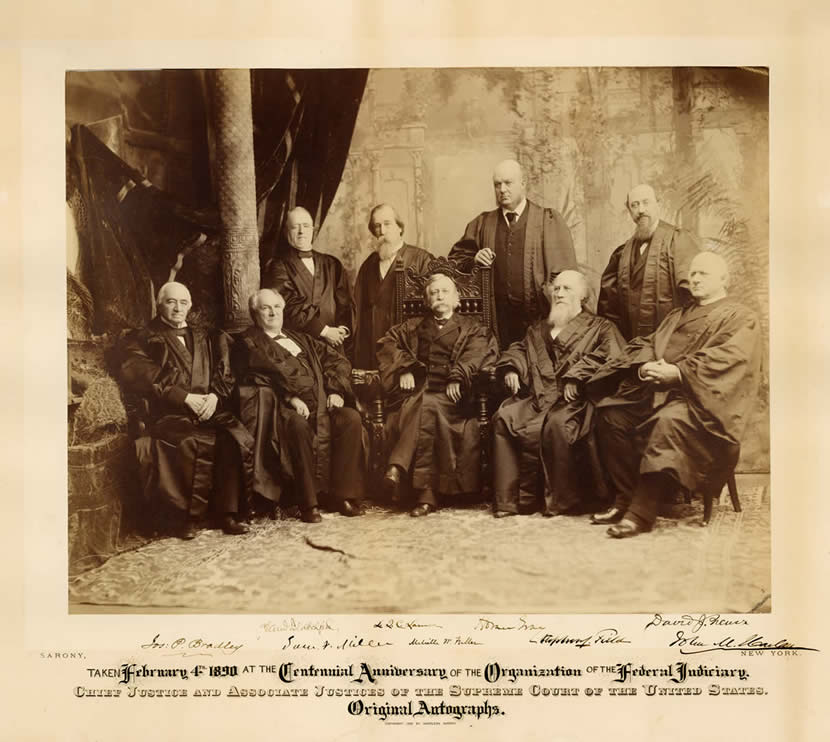 Seated, from left: Justices Joseph P. Bradley and Samuel F. Miller, Chief Justice Melville W. Fuller, and Justices Stephen J. Field and John Marshall Harlan; standing, from left: Justices Samuel Blatchford, Lucius Q. C. Lamar, Horace Gray and David J. Brewer
Seated, from left: Justices Joseph P. Bradley and Samuel F. Miller, Chief Justice Melville W. Fuller, and Justices Stephen J. Field and John Marshall Harlan; standing, from left: Justices Samuel Blatchford, Lucius Q. C. Lamar, Horace Gray and David J. Brewer
In February 1890, the Justices traveled to New York City to commemorate the 100th anniversary of the first meeting of the Supreme Court of the United States, where they also posed for a group photograph by celebrated photographer Napoleon Sarony. It remains the only official group photograph ever taken outside Washington, D.C.
The Canadian-born Sarony was a colorful character and well-known portrait photographer whose primary subjects were the actors and actresses of the theater world. He had also been a plaintiff before the Supreme Court six years earlier, in the landmark copyright case Burrow-Giles Lithographic Co. v. Sarony (1884), which established that photographers can copyright their own work and thus control how it is used. In the 1880s, Bell had recast the setting from plain to dignified, but Sarony “turned a solemn tradition on its ear” by posing the Justices in a delightfully chaotic corner of his studio with a rumpled carpet, ropes dangling from the ceiling, and drapery flung over fish netting and bales of hay.
The Fuller Court, October 1894 (pose no. 2)
Attributed to Clarence Dodge (1847-1914) for the C. M. Bell Studio (1872-1909)
1 / 2
Seated, from left: Justices Horace Gray and Stephen J. Field, Chief Justice Melville W. Fuller, and Justices John Marshall Harlan and David J. Brewer; standing from left: Justices Howell E. Jackson, Henry B. Brown, George Shiras, Jr. and Edward Douglass White
2 / 2
Seated, from left: Justices Horace Gray and Stephen J. Field, Chief Justice Melville W. Fuller, and Justices John Marshall Harlan and David J. Brewer; standing from left: Justices Howell E. Jackson, Henry B. Brown, George Shiras, Jr. and Edward Douglass White
❮
❯
On Saturday, October 13, 1894, the Justices met at the C.M. Bell Studio to sit for a new group photograph. At this session, they resolved their seating arrangement for good. Since 1882 there had always been five seated Justices in front and four standing behind, although the configurations varied. But from this point on, the Chief Justice is always seated in the middle and the others stagger outward by seniority from the Chief Justice’s right, right to left and front to back, so that the newest member of the Court is always found in the back row and on the far right. (Click on the arrows to see this sequence.)
Gathering for the group photograph was not a high priority for the Justices, and it took them seven months before they finally met at Bell’s studio. In the 19th century, the Court missed half of the opportunities to pose together after the arrival of a new member. That changed at the turn of the 20th century, after which nearly every complete Court lasting three months or more has been photographed.